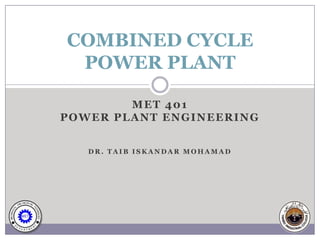
MET 401 Chapter 7 -_combined_cycle_power_plant
- 1. COMBINED CYCLE POWER PLANT MET 401 POWER PLANT ENGINEERING DR. TAIB ISKANDAR MOHAMAD
- 2. COGENERATION Many industries require energy input in the form of heat, called process heat. Process heat in these industries is usually supplied by steam at 5 to 7 atm and 150 to 200°C. Energy is usually transferred to the steam by burning coal, oil, natural gas, or another fuel in a furnace. Industries that use large amounts of process heat also consume a large amount of electric power. It makes sense to use the already- existing work potential to produce power instead of letting it go to waste. The result is a plant that produces electricity while meeting the process-heat requirements of certain industrial processes (cogeneration plant) A simple process-heating plant. Cogeneration: The production of more than one useful form of energy (such as process heat and electric power) from the same energy source. 2
- 3. Utilization factor • The utilization factor of the ideal steam-turbine cogeneration plant is 100%. • Actual cogeneration plants have utilization factors as high as 80%. • Some recent cogeneration plants have even higher utilization factors. An ideal cogeneration plant. 3
- 4. At times of high demand for process heat, all the steam is routed to the process-heating units and none to the condenser (m7= 0). The waste heat is zero in this mode. If this is not sufficient, some steam leaving the boiler is throttled by an expansion or pressure- reducing valve to the extraction pressure P6 and is directed to the process-heating unit. Maximum process heating is realized when all the steam leaving the boiler passes through the PRV (m5= m4). No power is produced in this mode. When there is no demand for process heat, all the steam passes through the turbine and the condenser (m5=m6=0), and the cogeneration plant operates as an ordinary steam power plant. A cogeneration plant with adjustable loads. 4
- 5. COMBINED GAS–VAPOR POWER CYCLES • The continued quest for higher thermal efficiencies has resulted in rather innovative modifications to conventional power plants. • A popular modification involves a gas power cycle topping a vapor power cycle, which is called the combined gas–vapor cycle, or just the combined cycle. • The combined cycle of greatest interest is the gas-turbine (Brayton) cycle topping a steam-turbine (Rankine) cycle, which has a higher thermal efficiency than either of the cycles executed individually. • It makes engineering sense to take advantage of the very desirable characteristics of the gas-turbine cycle at high temperatures and to use the high-temperature exhaust gases as the energy source for the bottoming cycle such as a steam power cycle. The result is a combined gas–steam cycle. • Recent developments in gas-turbine technology have made the combined gas– steam cycle economically very attractive. • The combined cycle increases the efficiency without increasing the initial cost greatly. Consequently, many new power plants operate on combined cycles, and many more existing steam- or gas-turbine plants are being converted to combined-cycle power plants. • Thermal efficiencies over 50% are reported. 5
- 6. Combined gas–steam power plant. 6
- 7. Example: Combined power plant 7 Consider the combined gas–steam power cycle shown. The topping cycle is a gas-turbine cycle that has a pressure ratio of 8. Air enters the compressor at 300 K and the turbine at 1300 K. The isentropic efficiency of the compressor is 80 percent, and that of the gas turbine is 85 percent. The bottoming cycle is a simple ideal Rankine cycle operating between the pressure limits of 7 MPa and 5 kPa. Steam is heated in a heat exchanger by the exhaust gases to a temperature of 500°C. The exhaust gases leave the heat exchanger at 450 K. Determine a) the ratio of the mass flow rates of the steam and the combustion gases b) the thermal efficiency of the combined cycle.
- 9. Example 2: Cogeneration plant Consider the cogeneration plant shown. Steam enters the turbine at 7 MPa and 500°C. Some steam is extracted from the turbine at 500 kPa for process heating. The remaining steam continues to expand to 5 kPa. Steam is then condensed at constant pressure and pumped to the boiler pressure of 7 MPa. At times of high demand for process heat, some steam leaving the boiler is throttled to 500 kPa and is routed to the process heater. The extraction fractions are adjusted so that steam leaves the process heater as a saturated liquid at 500 kPa. It is subsequently pumped to 7 MPa. The mass flow rate of steam through the boiler is 15 kg/s. Disregarding any pressure drops and heat losses in the piping and assuming the turbine and the pump to be isentropic, determine (a) the maximum rate at which process heat can be supplied, (b) the power produced and the utilization factor when no process heat is supplied, and (c) the rate of process heat supply when 10 percent of the steam is extracted before it enters the turbine and 70 percent of the steam is extracted from the turbine at 500 kPa for process heating.
